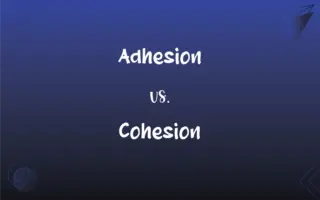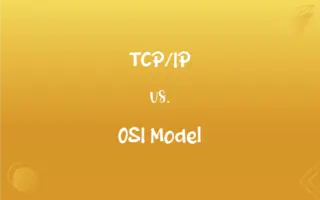Telophase 1 vs. Telophase 2: What's the Difference?
Edited by Janet White || By Harlon Moss || Updated on October 17, 2023
Telophase 1 concludes meiosis I with two haploid cells; Telophase 2 ends meiosis II, resulting in four genetically varied haploid cells.

Key Differences
Telophase 1 and Telophase 2 are distinct stages in the complex process of meiosis. Meiosis is a type of cell division that produces gametes, which are essential for sexual reproduction. Telophase 1 is the final stage of the first meiotic division, while Telophase 2 concludes the second meiotic division.
In Telophase 1, the cell undergoes cytokinesis to form two daughter cells. These cells are haploid, meaning they contain half the number of chromosomes as the original cell. Each chromosome still consists of two sister chromatids. In contrast, during Telophase 2, the sister chromatids separate, and the cell undergoes another round of cytokinesis. This results in the formation of four non-identical haploid cells, each containing a unique set of chromosomes.
The primary objective of Telophase 1 is to ensure the successful segregation of homologous chromosomes into separate daughter cells. On the other hand, the goal of Telophase 2 is to separate the sister chromatids and distribute them into four distinct cells, ensuring genetic diversity.
The genetic content and configuration of the cells at the end of each phase are another point of distinction. After Telophase 1, the two resultant cells have chromosomes that still consist of two chromatids. However, by the end of Telophase 2, the four resulting cells have chromosomes reduced to single chromatids.
The physical appearances of the cells at the conclusion of these phases also differ. Following Telophase 1, the two daughter cells usually appear larger and more similar to each other. After Telophase 2, the four cells are often smaller and exhibit greater variability due to genetic recombination and independent assortment.
ADVERTISEMENT
Comparison Chart
Division Stage
Ends the first meiotic division
Concludes the second meiotic division
Number of Resultant Cells
Two
Four
Chromosome Configuration
Chromosomes composed of two chromatids
Chromosomes reduced to single chromatids
Genetic Content
Haploid cells with homologous chromosome pairs separated
Haploid cells with unique sets of chromosomes
Objective
Segregate homologous chromosomes
Separate sister chromatids and ensure diversity
ADVERTISEMENT
Telophase 1 and Telophase 2 Definitions
Telophase 1
The final phase of the first meiotic division.
During Telophase 1, the cell prepares to split into two daughter cells.
Telophase 2
The concluding phase of the second meiotic division.
Telophase 2 finalizes meiosis II by ensuring the sister chromatids separate.
Telophase 1
The phase where nuclear envelopes may begin to form around chromosomes.
By the end of Telophase 1, new nuclear envelopes start to encase the separated chromosomes.
Telophase 2
Precedes the second cytokinesis in meiosis.
The cell undergoes cytokinesis immediately after Telophase 2.
Telophase 1
Precedes cytokinesis in meiosis I.
Following Telophase 1, the cell undergoes cytokinesis to form two separate cells.
Telophase 2
Results in the formation of four genetically distinct cells.
Following Telophase 2, four unique haploid cells are produced.
Telophase 1
The stage where homologous chromosomes reach opposite poles.
Telophase 1 ensures that each daughter cell receives a full set of haploid chromosomes.
Telophase 2
Ensures genetic diversity in gametes.
The genetic variability observed in gametes is a result of events during Telophase 2.
Telophase 1
Sets the stage for the second meiotic division.
After Telophase 1, the cell enters meiosis II, starting with Prophase II.
Telophase 2
The stage where nuclear envelopes reform around individual chromatids.
During Telophase 2, nuclear envelopes encapsulate the single chromatids.
FAQs
What is Telophase 1?
Telophase 1 is the final stage of the first meiotic division, resulting in two haploid daughter cells.
How does Telophase 2 differ from Telophase 1?
Telophase 2 concludes the second meiotic division, producing four genetically varied haploid cells.
How many cells are produced at the end of Telophase 2?
Telophase 2 results in the formation of four distinct haploid cells.
Why is Telophase 1 significant?
Telophase 1 ensures the segregation of homologous chromosomes into separate daughter cells.
Are chromosomes still paired after Telophase 1?
After Telophase 1, chromosomes are not paired, but each chromosome still consists of two chromatids.
What follows Telophase 1 in meiosis?
After Telophase 1, the cell enters meiosis II, starting with Prophase II.
What ensures genetic diversity in meiosis?
Genetic diversity is ensured by events during Telophase 2 and earlier stages of meiosis like crossing over.
Is cytokinesis part of Telophase 1 or Telophase 2?
Cytokinesis follows both Telophase 1 and Telophase 2, resulting in the physical separation of cells.
Are the cells after Telophase 2 ready to be gametes?
Yes, the cells produced after Telophase 2 are gametes, either sperm or egg cells, depending on the organism.
What precedes Telophase 1 in meiosis?
Anaphase 1 precedes Telophase 1 in meiosis.
Is the number of chromosomes halved in Telophase 1 or Telophase 2?
The number of chromosomes is halved during Telophase 1, but they still consist of two chromatids each.
How many chromatids does each chromosome have at the end of Telophase 1?
Each chromosome has two chromatids at the end of Telophase 1.
Are the cells at the end of Telophase 1 identical?
No, the two cells produced at the end of Telophase 1 have variations due to events like crossing over.
How many times do cells divide in meiosis?
Cells divide twice in meiosis: once after Telophase 1 and again after Telophase 2.
Do Telophase 1 and Telophase 2 look identical under a microscope?
No, cells after Telophase 1 are larger and have chromosomes with two chromatids, while cells after Telophase 2 are smaller with single-chromatid chromosomes.
What ensures that each cell after Telophase 1 gets a complete set of chromosomes?
The segregation of homologous chromosomes during Telophase 1 ensures each cell gets a complete haploid set.
Why is Telophase 2 critical for sexual reproduction?
Telophase 2 produces genetically varied gametes, which contribute to the genetic diversity of offspring.
What happens to the nuclear envelope during Telophase 1?
During Telophase 1, the nuclear envelope may begin to reform around the chromosomes.
Do the cells produced after Telophase 2 have the same genetic content?
No, the cells produced after Telophase 2 are genetically diverse.
How many meiotic divisions are there?
There are two meiotic divisions: meiosis I (ending with Telophase 1) and meiosis II (ending with Telophase 2).
About Author
Written by
Harlon MossHarlon is a seasoned quality moderator and accomplished content writer for Difference Wiki. An alumnus of the prestigious University of California, he earned his degree in Computer Science. Leveraging his academic background, Harlon brings a meticulous and informed perspective to his work, ensuring content accuracy and excellence.
Edited by
Janet WhiteJanet White has been an esteemed writer and blogger for Difference Wiki. Holding a Master's degree in Science and Medical Journalism from the prestigious Boston University, she has consistently demonstrated her expertise and passion for her field. When she's not immersed in her work, Janet relishes her time exercising, delving into a good book, and cherishing moments with friends and family.































































